 |
 |
|
"I told them my story�they did not believe it. I now tell it to you�and I can scarcely expect you to put more faith in it than did the merry fishermen of Lofoden." . . . . "Not long ago," said he at length, "and I could have guided you on this route as well as the youngest of my sons; but, about three years past, there happened to me an event such as never happened to mortal man�or at least such as no man ever survived to tell of�and the six hours of deadly terror which I then endured have broken me up body and soul. You suppose me a very old man�but I am not. It took less than a single day to change these hairs from a jetty black to white, to weaken my limbs, and to unstring my nerves, so that I tremble at the least exertion, and am frightened at a shadow." (EAP) | ||
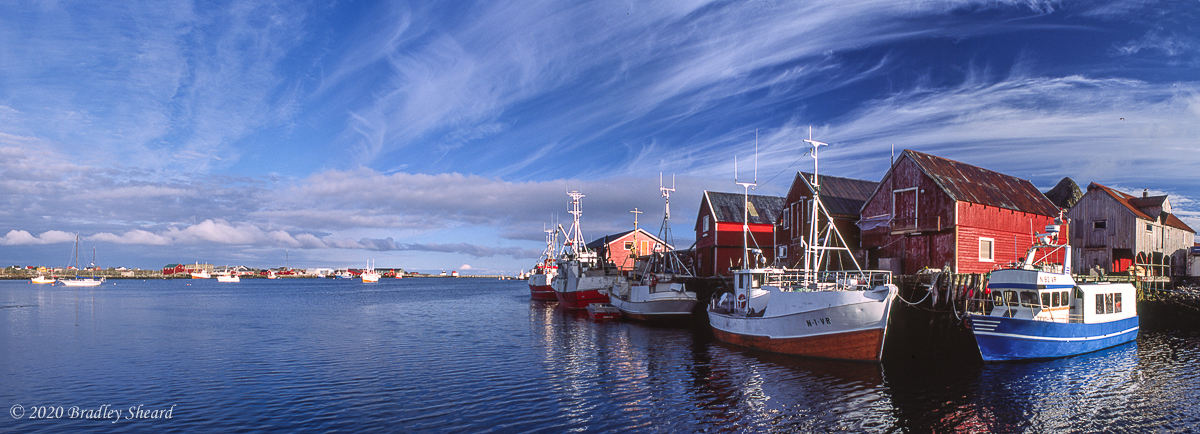 | ||
| A fishing village in the Lofoten Islands (2005) | ||
|
Frightened at a shadow. The phrase has special meaning to me, even now, years after the event that still haunts my dreams. The place it brings to mind is a world based on shadows, where sunlight is swallowed by waters choked with ebony silt as fine as lampblack. Millennia ago, when the level of the earth's oceans lay hundreds of feet below their present norm, an ancient Hudson River roared across the continental shelf with a torrent that could only be fed by the massive glaciers covering half the continent. Thousands of years of erosion carved a deep river valley from today's New York Harbor out to the very edge of the continental shelf. When the glaciers retreated and the seas rose once again, the remnant of that mighty river became a vast undersea canyon, filled with silt and sediment carried by both the glacial melt water and the modern Hudson. Fishermen call the mouth of that ancient river, at the very edge of the oceanic abyss, the Hudson Canyon. Divers call the meandering, mud-filled trench connecting New York Harbor with the Hudson Canyon, the "Mudhole." | ||
|
"Kircher and others imagine that in the centre of the channel of the Maelstr�m is an abyss penetrating the globe, and issuing in some very remote part�the Gulf of Bothnia being somewhat decidedly named in one instance." (EAP) | ||
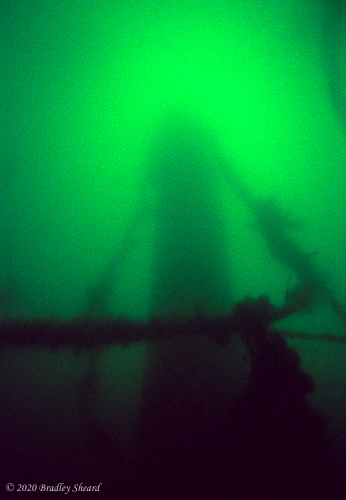 |
And so it seems with the Mudhole. A boat traveling east from the northern New Jersey shore, its crew watching an electronic trace of the sea floor painted in magnificent color on a depth recorder, will notice a sudden and sharp turn downward some nine miles from the beach. It is as if the bottom dropped out of the ocean, and the coastal depths of 100 feet double to 200 feet, or more, in little more than 1�2 mile. Continuing west, crossing the hidden valley, one is left to wonder what lies below. Then, just as quickly, the ocean bottom rises to a more palatable level, as if the deep abyss below was nothing more than a mirage�an electronic phantom buried deep in the depth recorder's programming. | ||
|
"Presently our little boat gave herself a shake, just as a dog does in coming out of the water, and thus rid herself, in some measure, of the seas. I was now trying to get the better of the stupor that had come over me, and to collect my senses so as to see what was to be done, when I felt somebody grasp my arm. It was my elder brother, and my heart leaped for joy, for I had made sure that he was overboard�but the next moment all this joy was turned into horror�for he put his mouth close to my ear, and screamed out the word "Moskoe-str�m!" (EAP) |
By more than simple chance, ships entering and exiting the great Harbor of New York unknowingly both cross, and follow, this ancient, hidden river channel. And wherever ships ply the seas, at least a few will sink�and so, by more than simple chance, there are a scattering of broken ships lying in the depths of this submerged ravine left over from the Pleistocene Epoch. To divers�those explorers of the depths that seek out sunken ships�the call to descend to these decaying vessels is strong, despite the dangers inherent in the venture. And so we�my companions and I�set forth to explore a tiny ship, of near legendary status among our bretheren, lying nearly in the bottom of the trench�the Chilean freighter Choapa. Known only to hard-core wreck divers and shipwreck fanatics, the wreck's reputation is a frightening one. To some, the famous liner Andrea Doria�as challenging a dive as she is�is considered a prerequisite�a mere training dive to be completed before diving Choapa. She lies two-hundred-feet beneath the surface in a bed of fine, sooty silt that sops up sunlight like a sponge, cloaking her world with a perpetual darkness akin to a moonless night in the wilderness. |
||
|
"In the meantime the breeze that had headed us off fell away, and we were dead becalmed, drifting about in every direction. This state of things, however, did not last long enough to give us time to think about it. In less than a minute the storm was upon us�in less than two the sky was entirely overcast�and what with this and the driving spray, it became suddenly so dark that we could not see each other in the smack." (EAP) | ||
|
Choapa's life afloat ended during the 2nd Great War�December 1944�but not at the hands of the enemy, rather by the precautionary measures taken to safeguard her kind against the foe. A casualty of collision between ships in a game of billiards outside the entrance to New York Harbor, the small Chilean freighter passed from this existence into the underworld of lost and broken ships. As she fell from one world to the next, landing in the depths of the aforementioned ancient trench, she metamorphosed from an instrument of transport into an empty steel skeleton, destined for slow, relentless burial by a rain of silt and river effluent flowing from the remnant of that boisterous Hudson of prehistory. | ||
|
"When it is flood, the stream runs up the country between Lofoden and Moskoe with a boisterous rapidity; but the roar of its impetuous ebb to the sea is scarce equaled by the loudest and most dreadful cataracts; the noise being heard several leagues off, and the vortices or pits are of such an extent and depth, that if a ship comes within its attraction, it is inevitably absorbed and carried down to the bottom, and there beat to pieces against the rocks; and when the water relaxes, the fragments thereof are thrown up again. (EAP) | ||
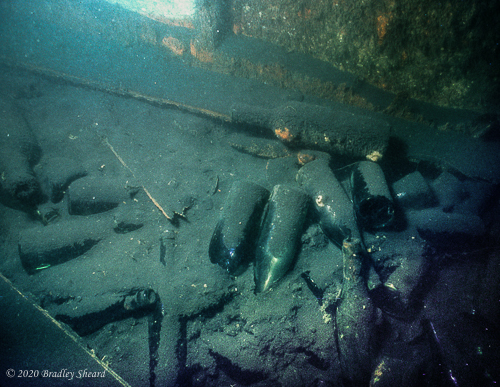 | 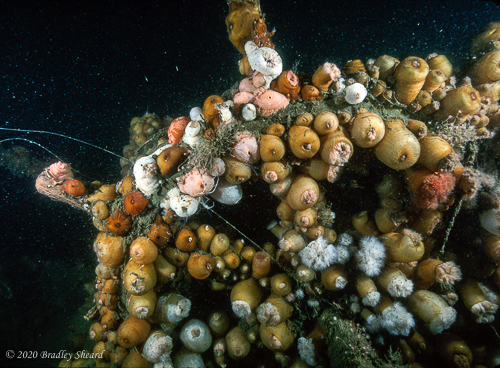 |
| A proliferation of wine bottles lying in fine black silt inside Choapa's bridge | Heavily studded with sea anemones, one of Choapa's aft helms stood for many years on the ship's poop deck |
|
Our explorations at the bottom of the pit are at times more tactile than visual, a largely unpredictable consequence of the flow of tide, current and suspended sediment. We drop through the water column in pairs, following a thin thread of nylon into the depths of the abyss. The light of the sun fades first into shades of colorless grey, then dwindles to black as we land on the decks of an alien world. | ||
|
"As I felt the sickening sweep of the descent, I had instinctively tightened my hold upon the barrel, and closed my eyes. For some seconds I dared not open them�while I expected instant destruction, and wondered that I was not already in my death-struggles with the water. But moment after moment elapsed. I still lived. The sense of falling had ceased; and the motion of the vessel seemed much as it had been before, while in the belt of foam, with the exception that she now lay more along. I took courage, and looked once again upon the scene." (EAP) | ||
|
We feel our way through the blackness, hand-over-hand across rusted steel plate, past living carpets of bulbous pustules of protoplasm, and through gossamer filaments of fishing line that resemble the cobwebs found in the remote corners of an abandoned house that have never seen the sun. My partner snaps on a battery-powered lamp, its brilliance shattering the darkness. Behold�the dead ship materializes before our eyes! | ||
|
"By this time the first fury of the tempest had spent itself or perhaps we did not feel it so much, as we scudded before it, but at all events the seas, which at first had been kept down by the wind, and lay flat and frothing, now got up into absolute mountains. A singular change, too, had come over the heavens. Around in every direction it was still as black as pitch, but nearly overhead there burst out, all at once, a circular rift of clear sky�as clear as I ever saw�and of a deep bright blue�and through it there blazed forth the full moon with a lustre that I never before knew her to wear. She lit up every thing about us with the greatest distinctness�but, oh God, what a scene it was to light up!" (EAP) | ||
|
What is perhaps most startling about the scene before us is the extraordinary contrast, between the enveloping pitch darkness of the abyss, and the warm light spilling from the lantern onto the rusted steel plates and patchwork quilt of living color that has taken root here. Alas it is all a blur to me, for my mind has withdrawn into some remote corner of my skull today, leaving behind only the most intense stupor�the most acute rapture of the deep that I have ever felt. My body is numb�anesthetized by nitrogen�but of greater consequence is a complete loss of mental faculties. It is as if I am both conscious and unconscious at the same time, a soulless and empty shell wandering the depths aimlessly but for the guiding hand of my dive partner. I feel mindless, but at the same time I am paralyzed by fear, for deep in my being I know that I am in a perilous place that shows no kindness to fools. | ||
|
"Never shall I forget the sensations of awe, horror, and admiration with which I gazed about me. The boat appeared to be hanging as if by magic, midway down, upon the interior surface of a funnel vast in circumference, prodigious in depth, and whose perfectly smooth sides might have been mistaken for ebony, but for the bewildering rapidity with which they spun around, and for the gleaming and ghastly radiance they shot forth, as the rays of the full moon, from that circular rift amid the clouds which I have already described, streamed in a flood of golden glory along the black walls, and far away down into the inmost recesses of the abyss." (EAP) | ||
|
We did have a mission to fulfill this day. The team of two that had preceded us had swum a second anchor line to the ship's bridge and tied it there. It was left to the second team, my partner and I, to free the line we descended upon and send it to the surface on a lift bag, then hope we could grope our way across Choapa's decks and find the second line before our bottom time had expired. As we watched the lift bag rise, taking with it our primary link to the surface, and safety, we found ourselves alone in the abyss, with all hope pinned upon our ability to navigate the broken ship and find that second line�a line we had not yet seen, and who's exact location was unknown to us�for it was our link to the world we had left behind. And so we began to wander about the depths in search of a thin strand of nylon that would lead us home. | ||
|
"It may look like boasting�but what I tell you is the truth�I began to reflect how magnificent a thing it was to die in such a manner, and how foolish it was in me to think of so paltry a consideration as my own individual life, in view of so wonderful a manifestation of God's power. I do believe that I blushed with shame when this idea crossed my mind. After a little while I became possessed with the keenest curiosity about the whirl itself. I positively felt a wish to explore its depths, even at the sacrifice I was going to make; and my principal grief was that I should never be able to tell my old companions on shore about the mysteries I should see. These, no doubt, were singular fancies to occupy a man's mind in such extremity�and I have often thought since, that the revolutions of the boat around the pool might have rendered me a little light-headed." (EAP) | ||
|
As if guided by some higher power, my hand suddenly found itself grasped around that thin string of nylon that my mind instinctually knew, ingrained deeply by years of training, would lead to the surface�and salvation. I have little memory of how we had gotten there. The higher power that had guided me and placed my hand on that line was, of course, my dive buddy Pat Rooney, and it was he who had led me through this short odyssey across the decks of the Choapa, from the deepest, darkest recesses of my unconscious mind back to the doorstep of reality. The feel of the nylon line in my gloved hand broke the spell that had captured my senses, and the awareness that had escaped me suddenly�instantly�flooded my brain once more, and at that moment I knew I would live to see the sun once again. Just how we transited the wreck would remain a mystery to me, but I let my instincts take over and began my ascent, leaving behind that horrible world of darkness and started my return to the light. | ||
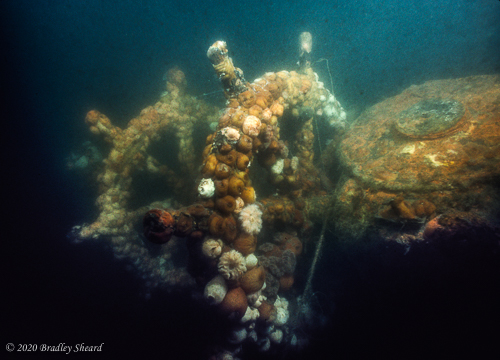 | 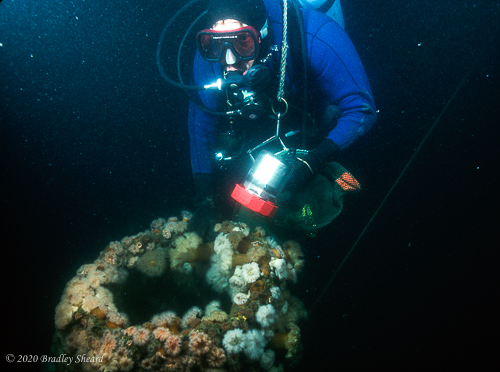 |
| Double helm on Choapa's stern | Jeff Pagano peers into one of the ship's ventilator stacks |
All images, text and content Copyright © Bradley Sheard. All rights reserved.